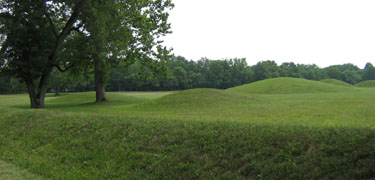 Last week I had the opportunity to visit Hopewell Mound City in southern Ohio. It is one of the nine archeological sites of monumental earthworks constructed by the Ohio Hopewell culture during the Woodland Period (1-1000 CE) which together have been added to the tentative list by the United States Government for consideration for World Heritage status.
Last week I had the opportunity to visit Hopewell Mound City in southern Ohio. It is one of the nine archeological sites of monumental earthworks constructed by the Ohio Hopewell culture during the Woodland Period (1-1000 CE) which together have been added to the tentative list by the United States Government for consideration for World Heritage status.The park protects the prehistoric remains of a dynamic social and ceremonial phenomenon that flourished in the woodlands of eastern North America between 200 B.C. and A.D. 500. The term Hopewell describes a broad network of economic, political, and spiritual beliefs and practices among different Native American groups. The culture is characterized by the construction of enclosures made of earthen walls, often built in geometric patterns and mounds of various shapes. The culture is known for a network of contacts with other groups, which stretched from the Atlantic coast to the Rocky Mountains. This network brought materials such as mica, shark's teeth, obsidian, copper, and shells to Ohio.The visitor center includes a video presentation and a small museum which helped to understand the artifacts collected from the site as well as the historical importance of the Hopewell people. We were especially grateful for the attention of three National Park Service staff members who work in the visitors's center and who spent considerable time explaining the site and its history.
I was especially taken by the fact that the site included objects made of copper that came from Canada, Obsidian from deposits near Yellowstone, mica from the Carolinas, and shells from the Gulf coast. While this was a culture that lived on hunting and gathering, the Hopewell peoples also understood astronomy, could build large earthwork structures, and obtained materials that they valued from all over the North American continent.
World Heritage status for the sites preserving the monuments of the Hopewell culture may help Americans to recognize the accomplishments of the people who lived on the continent before 1492. I wish that all the school children in the United States would learn about the pre-Columbian cultures of the continent!

No comments:
Post a Comment